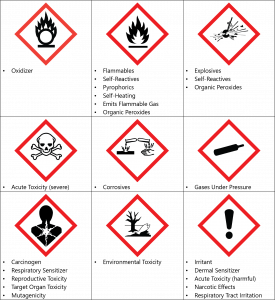Chemical labeling and signage communicate dangers posed by hazardous materials in the workplace. The system of labeling/signage was established by the Hazard Communication Standard (Cal-OSHA 8 CCR §5194) which defines how various hazards of chemicals are to be categorized and creates a hazard communication language of standardized signal words, phrases, and pictograms to be used in labels and safety data sheets. The standard aligns with the Globally Harmonized Systems (GHS) developed by the United Nations (UN).
GHS
The GHS provides an employer the means by which to effectively communicate the hazards associated with certain chemicals. Note that in OSHA/GHS labeling, lower alphanumeric category indicates a more serve hazard.
Components of the OSHA/GHS labeling system include the following:
- Product identifier
- Signal word
- Hazard statement(s)
- Precautionary statement(s)
- Pictogram(s) (see figure below)
- Name, address, and telephone number of the manufacturer, importer or other responsible party.

Follow general labeling rules and guidelines outlined below:
- Do not remove or deface original labels from hazardous material containers unless the containers are empty and contaminant-free. See Hazardous Waste Disposal Guide Sheet.
- Date all incoming hazardous materials when received and opened.
- Label everything except substances or experimental setups under the control of the user.
- Include the following elements for internal labelling within a research lab:
- Sufficient information for lab personnel to identify the general hazards known or predicted to be posed by the substance, AND;
- Either the chemical name or an identifier which can be correlated with a list of abbreviations or lab book, AND;
- The date when the sample was prepared.
- Label all storage containers and cabinets to identify the hazardous nature of products stored within. Download and print the appropriate GHS labels and affix them to storage cabinets, freezers, or containers. The templates below are for Avery 5160 or equivalent label types.
- Label Unattended experiments with clear signage in the immediate vicinity as outlined in the guide sheet.
For more detailed labeling information as well as a guide to understanding the NFPA ratings, refer to the CHP.